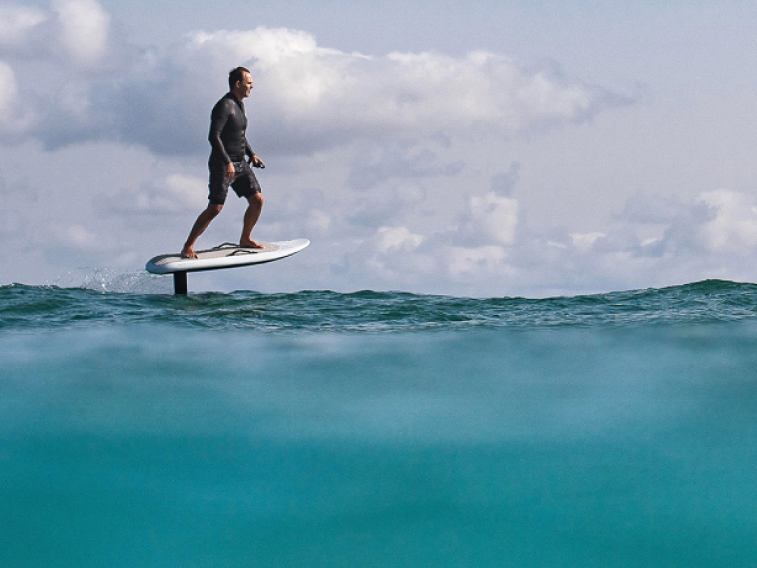Quality trophy homes continue to be sought after even as the rate of growth in the wider market moderates.


Article
From Silicon Valley scholarships to Byron Bay surfs via the Melbourne ad business, connecting the dots has led to Fliteboard founder David Trewern living out his teenage dreams—inadvertently creating a world-leading brand in the process.

In 1995, newly graduated 19-year-old David Trewern left Melbourne for San Francisco on a travel scholarship awarded by the Australian Graphic Design Association. He joined pioneering tech company Netscape as an intern, just as it first floated on the US stock exchange, in the early days of the World Wide Web. Three decades later, that experience proves to have been the perfect foundation for a serial entrepreneur and tech pioneer. After years spent building creative technology businesses, Trewern’s design skills and Silicon Valley-inspired innovation mindset eventually dovetailed with his love of the ocean to give rise to the most professionally successful and personally satisfying chapter of his life so far—as founder and co-CEO of electric hydrofoil surfboard brand Fliteboard.
Launched in 2016, Fliteboard is the result of a DIY passion project that Trewern started at home while on a year-long sabbatical from the stresses of the business world. After outgrowing the family kitchen, the eFoil company decamped to its current Byron Bay headquarters and now boasts a staff of more than 100 including naval architects, hydrodynamicists and software engineers spanning offices in Australia, The Netherlands and the US. Fliteboard customers, meanwhile, can be found in 90 countries. Within five years it was generating more than $50m in sales and attracting investors such as Victor Smorgon, Afterpay’s Anthony Eisen and golfer Adam Scott. It also counts Australian design luminary Marc Newson among its collaborators, and has found fans in everyone from Google co-founder Larry Page to legendary big-wave surfer Laird Hamilton.
As a youngster, Trewern assumed he would become an architect like his father. When he was later drawn to study industrial design and explained to an RMIT admissions officer that he wanted to design cars, he was swiftly set straight that such a career was not an option in Australia and redirected toward graphic design. He recalls: “I wanted to get my hands dirty, solve problems and get more multidimensional, so I got into multimedia design and taught myself programming.” He admits to being puzzled when he first saw designer roles advertised in San Francisco; “I didn’t even know what the internet was, or if you could design for it. When I got home I thought about it more, realised it was the future, and in September 1996 started Australia’s first web development company in DTDesign.”
Looking back, he is amused at the DIY nature of the early web. “My first project out of uni was to design the Mercedes-Benz website, purely because there was no one else with a design background who knew about coding,” he explains. “That led to building bunnings.com and myer.com, and we ended up a 300-person digital agency.” In 2007, Trewern sold the business to the STW Group with a three-year earnout. “I didn’t really have a plan,” he says. “[I was asking myself] am I more scared of doing the same thing forever and getting stuck, or of taking on a new challenge and failing?” 02 He adds: “But, whenever that’s come up since, I’ve decided to take the leap and see what happens.”
The next five years saw Trewern occupy various leadership positions in the advertising and digital design realm before founding Republica, a private college aimed at filling holes in Australia’s digital workforce. By 2013, he was burnt out. He says: “I was very stressed and started to have health issues, so I sold out [of Republica] and moved to Byron Bay for a year off. I promised my wife Bethwyn that I wouldn’t come up with another business.”
With their seaside upbringings (her in Fiji, him in Merimbula), plus weekend homes in Portsea and Sandy Point, the couple share a lifelong connection to the ocean. The Byron move would give their children a similar experience. Trewern says he always found solace in surfing and kiting, and in 2005 set a new world speed record for kitesurfing (on a board he designed himself). Ten years on, it was actually a lack of wind that ended the self-induced sabbatical. “When we moved to Byron Bay I thought ‘I’m living on the beach, I can finally go kitefoiling every day, it’s going to be amazing’, but then I realised the wind’s no good till September,” he explains. “I was intrigued when I saw someone fly past on a petrol-powered jetboard, but that struck me as loud and obnoxious. I had the idea to hook up an electric motor to my foil and figured I’d be riding around on it by that afternoon.” How mistaken he was. “It’s one of those classic entrepreneur things where if you knew how hard it was going to be, you’d never do it, but you’re visualising the outcome before you’ve worked out how to get there,” he adds with a smile. Some 18 months later, he had a working prototype.
What started as a tinkering project had morphed into an obsession. Trewern recalls: “I had parts all over the lounge room, the 3D printer churning away downstairs, a soldering line going in the kitchen and my wife demanding to know what the hell I was doing.” When he casually posted a video of the experimental flying surfboard to Facebook, it garnered millions of views and comments. He set up a basic website “just to see what happens” and was bombarded with around 11,000 enquiries. Once his son devised the Fliteboard name and his brother created its logo, all that was left was to get permission from Bethwyn to come out of retirement. “I think she started to see that I was really coming alive from the project,” he muses. “She often says that it rewired my brain. After being in a pretty stressed-out state, all of a sudden I’d forgotten my worries and was back in my happy place.” For Trewern, the way to attain the mindful state so often touted by today’s self-help gurus was to embark on a new creative endeavour.
As Fliteboard’s offering continues to evolve—this year incorporating Marc Newson-designed accessories and the world’s lightest performance eFoil in the Ultra L2—its vision is clearly driven by a man living out his boyhood dream to design cool machines. He says: “If you take a Tesla and a surfboard and an iPhone and stick it all in a blender, that’s Fliteboard, right? It’s like I designed my perfect job; I was my own first customer, and it turns out there are a lot of other people in the world like me looking for freedom on the water.”
The opportunity to work with Newson—renowned for his eye-catching collaborations with the likes of Ferrari, Riva and Louis Vuitton—felt like stars aligning for Trewern, having long admired the London-based designer’s purity of form. “The universe has a funny way of making connections when intentions are strong,” he says. Another validating moment came when Laird Hamilton (who knows what it is like to upset surfing purists, having started the tow-in movement in the early 1990s) took the product for a spin. Trewern explains: “I expected him to be anti-eFoil but we were on the Mediterranean and he loved that he could still get a workout in without any waves. It made me realise there are two categories of people: the purists, who I totally respect for trying to protect the essence of their sport, and the pioneers, who are always asking what else we can do and don’t necessarily see one as cancelling out the other.”
Far from deterred when Puerto Rico-based Lift Foils hit the market around the same time as Fliteboard, Trewern revelled in the competition. “That fired me up more, if we weren’t going to be the first we could be the best, we had to earn our right to exist through innovation” he says. Key upgrades included integrating GPS technology and a trip computer that displays how many kilometres and minutes are left on each ride, among other ride stats. Through experimentation with composite materials, he has now managed to get the retail price down to around $11,000 for an entry-level board, half that of the first-generation model.
Populated with plenty of early adopters, the Fliteboard community is an enthusiastic one. “The app features a leaderboard so we’ve riders all around the world competing to see who can get the longest wave or the most minutes of unpowered riding,” says Trewern. There are avenues for eFoiling to become an officially recognised sport, with top speeds around 50km and no shortage of motivation from Fliteboard ambassadors such as Adam Bennetts, the Queenslander hailed as the world’s best foiler, and Hawaiian kitesurfing champion Moona Whyte.
At the other end of the spectrum, eFoiling can simply be a peaceful way to explore. “I’ve Fliteboarded around the Statue of Liberty, under the Golden Gate Bridge, around a volcanic island in Sicily, places you just can’t get to otherwise,” Trewern says. “Riding along the canals in Miami is great fun too, checking out the real estate, the boats, just exploring.” As well as watersports amateurs, this more laidback use case welcomes in mature surfers who would otherwise age out of the sport. Among these is retired Perth businessman Bill Mitchell, who says the fresh-air pursuit makes him feel far younger than his 76 years. He tells The Luxury Report: “I surfed until I got cancer and was told I might not walk again, let alone surf. I’m now on to my fifth Fliteboard and just ticked over 5000km. In The Rise Of Superman, Stephen Kotler talks about the flow state, and I find that when I’m foiling.”
The brand’s growth potential has not gone unnoticed by the wider recreational marine industry. Last year Mercury Marine (a subsidiary of US boating giant Brunswick Corporation) acquired Fliteboard for a reported US$90m, with Trewern now sharing chief executive duties with Wisconsin-based Nick Stickler. Though he never dreamed of selling his passion project, the opportunity to offload supply chain and manufacturing challenges to industry veterans while he focuses on product design proved irresistible. “My goal shifted from building a company that I wanted to work in all day, every day for the rest of my life, to wanting Fliteboard to be successful into the future,” he says. “We think this can be a billion-dollar market.” As to what this could all mean for his legacy, Trewern seems at peace; “All that matters is that I’m setting an example for my kids of living life to the fullest. Make mistakes, learn things, try things, go hard.”
The information contained in this article is gathered from multiple sources believed to be reliable as at August 2024 and is intended to be of a general nature only. It has been prepared without taking into account any person’s objectives, financial situation or needs. NAB does not guarantee the accuracy or reliability of any information in this article which is stated or provided by a third party. Before acting on this information, NAB recommends that you consider whether it is appropriate for your circumstances. NAB recommends that you seek independent legal, property, financial and taxation advice before acting on any information in this article. ©2024 NAB Private Wealth is a division of National Australia Bank Limited ABN 12 004 044 937 AFSL and Australian Credit Licence 230686.
Originally published in The Luxury Report, July 2024
© National Australia Bank Limited. ABN 12 004 044 937 AFSL and Australian Credit Licence 230686.